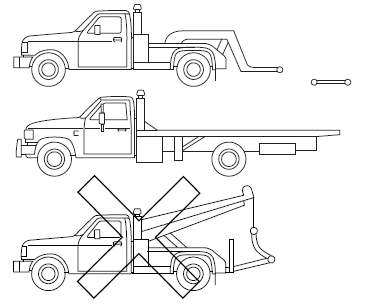Ford Escape: Wrecker towing

If you need to have your vehicle towed, contact a professional towing service or, if you are a member of a roadside assistance program, your roadside assistance service provider.
It is recommended that your vehicle be towed with a wheel lift and dollies or flatbed equipment. Do not tow with a slingbelt. Ford Motor Company has not approved a slingbelt towing procedure.
On FWD vehicles, if your vehicle is to be towed from the front, ensure proper wheel lift equipment is used to raise the front wheels off the ground. The rear wheels can be left on the ground when towed in this fashion.
If your vehicle is to be towed from the rear using wheel lift equipment, it is required that the front wheels (drive wheels) be placed on a dolly to prevent damage to the transmission.
On 4WD vehicles, it is required that your vehicle be towed with a wheel lift and dollies or flatbed equipment with all the wheels off the ground to prevent damage to the automatic transmission, 4WD system or vehicle.
Ford Motor Company produces a towing manual for all authorized tow truck operators. Have your tow truck operator refer to this manual for proper hook-up and towing procedures for your vehicle.
If the vehicle is towed by other means or incorrectly, vehicle damage may occur.
Emergency towing
In case of a roadside emergency with a disabled vehicle (without access to wheel dollies, car hauling trailer, or flatbed transport vehicle) your vehicle (regardless of transmission powertrain configuration) can be flat towed (all wheels on the ground) under the following conditions:
• Vehicle is facing forward so that it is being towed in a forward
direction.
• Place the transmission in N (Neutral). Refer to Brake-shift interlock
in the Driving chapter for specific instructions if you cannot move the
gear shift lever into N (Neutral).
• Maximum speed is not to exceed 35 mph (56 km/h).
• Maximum distance is 50 miles (80 km).
See also:
4WD lock system
4WD lock system (With Electronic Control 4WD) (If installed)
This 4WD system is designed for dividing the
power ratio automatically in normal driving conditions.
During off-road or low-friction driving conditions,
press the 4WD lock button ...
Automatic Transmission Fluid
Specified Fluid
Use an automatic transmission fluid SUZUKI ATF 3317 or Mobil ATF 3309.
Fluid Level Check
CAUTION: Driving with too much or too little fluid can damage the transmission.
You must check the fluid level with the automatic transmissio ...

 Jump starting
Jump starting